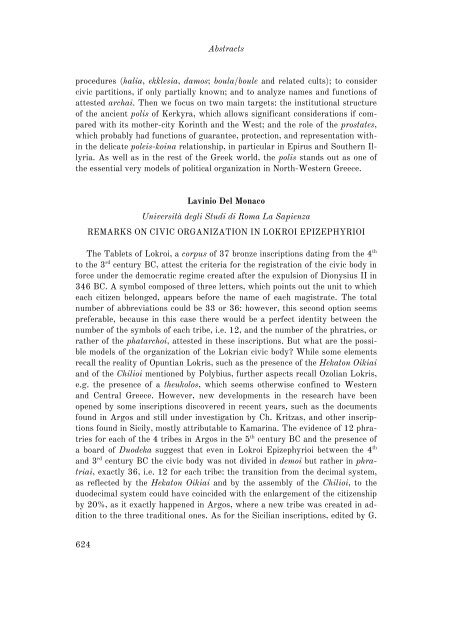Lo spazio ionico e le comunità della Grecia nord-occidentale
Lo spazio ionico e le comunità della Grecia nord-occidentale
Lo spazio ionico e le comunità della Grecia nord-occidentale
You also want an ePaper? Increase the reach of your titles
YUMPU automatically turns print PDFs into web optimized ePapers that Google loves.
624<br />
Abstracts<br />
procedures (halia, ekk<strong>le</strong>sia, damos; boula/bou<strong>le</strong> and related cults); to consider<br />
civic partitions, if only partially known; and to analyze names and functions of<br />
attested archai. Then we focus on two main targets: the institutional structure<br />
of the ancient polis of Kerkyra, which allows significant considerations if compared<br />
with its mother-city Korinth and the West; and the ro<strong>le</strong> of the prostates,<br />
which probably had functions of guarantee, protection, and representation within<br />
the delicate po<strong>le</strong>is-koina relationship, in particular in Epirus and Southern Illyria.<br />
As well as in the rest of the Greek world, the polis stands out as one of<br />
the essential very models of political organization in North-Western Greece.<br />
Lavinio Del Monaco<br />
Università degli Studi di Roma La Sapienza<br />
REMARKS ON CIVIC ORGANIZATION IN LOKROI EPIZEPHYRIOI<br />
The Tab<strong>le</strong>ts of <strong>Lo</strong>kroi, a corpus of 37 bronze inscriptions dating from the 4 th<br />
to the 3 rd century BC, attest the criteria for the registration of the civic body in<br />
force under the democratic regime created after the expulsion of Dionysius II in<br />
346 BC. A symbol composed of three <strong>le</strong>tters, which points out the unit to which<br />
each citizen belonged, appears before the name of each magistrate. The total<br />
number of abbreviations could be 33 or 36: however, this second option seems<br />
preferab<strong>le</strong>, because in this case there would be a perfect identity between the<br />
number of the symbols of each tribe, i.e. 12, and the number of the phratries, or<br />
rather of the phatarchoi, attested in these inscriptions. But what are the possib<strong>le</strong><br />
models of the organization of the <strong>Lo</strong>krian civic body? Whi<strong>le</strong> some e<strong>le</strong>ments<br />
recall the reality of Opuntian <strong>Lo</strong>kris, such as the presence of the Hekaton Oikiai<br />
and of the Chilioi mentioned by Polybius, further aspects recall Ozolian <strong>Lo</strong>kris,<br />
e.g. the presence of a theukolos, which seems otherwise confined to Western<br />
and Central Greece. However, new developments in the research have been<br />
opened by some inscriptions discovered in recent years, such as the documents<br />
found in Argos and still under investigation by Ch. Kritzas, and other inscriptions<br />
found in Sicily, mostly attributab<strong>le</strong> to Kamarina. The evidence of 12 phratries<br />
for each of the 4 tribes in Argos in the 5 th century BC and the presence of<br />
a board of Duodeka suggest that even in <strong>Lo</strong>kroi Epizephyrioi between the 4 th<br />
and 3 rd century BC the civic body was not divided in demoi but rather in phratriai,<br />
exactly 36, i.e. 12 for each tribe: the transition from the decimal system,<br />
as ref<strong>le</strong>cted by the Hekaton Oikiai and by the assembly of the Chilioi, to the<br />
duodecimal system could have coincided with the enlargement of the citizenship<br />
by 20%, as it exactly happened in Argos, where a new tribe was created in addition<br />
to the three traditional ones. As for the Sicilian inscriptions, edited by G.


